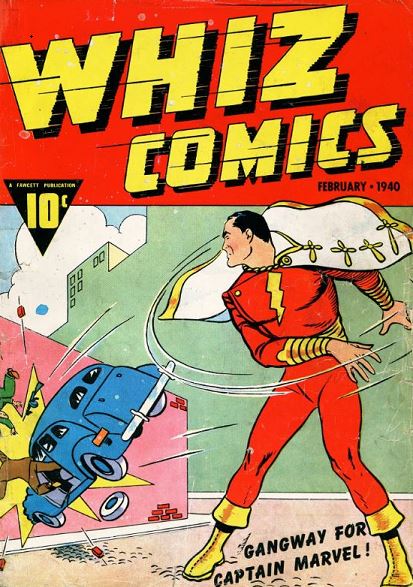
In 1940, Fawcett Comics introduced one of the most popular superheroes of the era— the original Captain Marvel.
Next month, Warner Bros will release a film about Captain Marvel, except both the film and the character are called Shazam, while on Friday Marvel Studios will release a film called Captain Marvel about a woman who has no connection to the Fawcett Comics character.
So, who is the Fawcett Comics Captain Marvel, how did he come to be associated with DC Comics and why does Marvel Comics also have a character (several characters, actually) with that name?
As related in Whiz Comics #2 (Feb. 1940), a young orphaned newsboy named Billy Batson is brought by a mysterious stranger before a 3,000-year-old Wizard named Shazam who makes Billy his successor. By uttering the wizard’s name, Billy becomes Captain Marvel and is endowed with the wisdom of Solomon, the strength of Hercules, the stamina of Atlas, the power of Zeus, the courage of Achilles and the speed of Mercury.
Captain Marvel, initially intended to be called Captain Thunder, was created by writer Bill Parker and artist C.C. Beck. The character proved to be an immediate hit and was the subject of a 12-chapter 1941 serial titled The Adventures of Captain Marvel. It was the first serial to focus on a superhero.
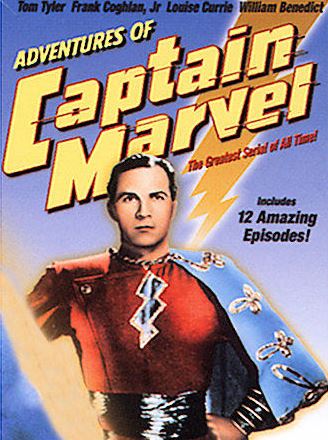
That same year, the company now known as DC Comics filed a copyright infringement against Fawcett Comics claiming Captain Marvel was too similar to Superman. In some respects, it should have been the other way around. Captain Marvel was flying from day one. Supes was leaping an 1/8 of a mile to get around in his early years.
At any rate, the case dragged on and was finally settled in 1953, with Fawcett agreeing to stop publishing. This was probably due as much to the decline in sales of comics in general as it was the result of the lawsuit. Either way, it seemed that Captain Marvel’s day was done.
In an ironic twist, DC Comics would license the rights to the character and revive him in 1973. He would star in a 35-issue title called Shazam, initially illustrated by C.C. Beck. That title ran until 1978.
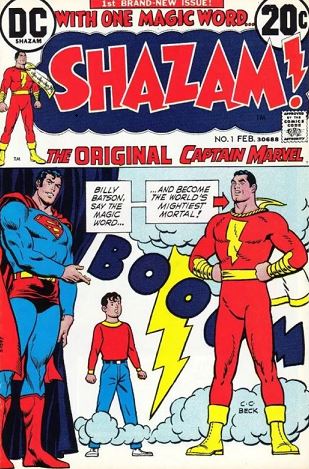
It’s ironic that Superman is re-introducing comics readers to the character.
But why was the book called Shazam instead of Captain Marvel? Because Fawcett Comics neglected to renew the trademark, which Marvel Comics secured (for obvious reasons) several years earlier. That name has been used by several characters in the Marvel universe, starting with a Kree warrior named Mar-Vell. At one point, he became trapped in the Negative Zone and could only return to our universe by exchanging places with Rick Jones via the use of “Nega-Bands.”
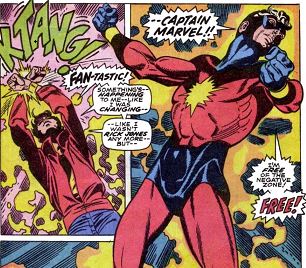
Rick Jones and Mar-Vell trade places.
Which isn’t much different than Billy Batson or Captain Marvel saying “Shazam” to change into one another.
The most recent Marvel Comics character to hold the title is Carol Danvers. She’s the focus of the Captain Marvel movie opening on Friday. I’m looking forward to seeing that movie later this month with some friends, but, for now, I’m going to keep my focus on the original.
For the record, it wasn’t always clear whether Billy Batson, who worked as a radio reporter for station WHIZ, and Captain Marvel were two separate people or whether Captain Marvel was essentially a super-powered Billy as an adult.
Captain Marvel was not only a mainstay in Whiz Comics, which ran for 155 issues, but also starred in Captain Marvel Adventures, which ran for 150 issues.
He soon became the head of a “Marvel family” that included Billy’s sister Mary, who was originally known as Mary Marvel, and Freddy Freeman, AKA Captain Marvel, Jr.
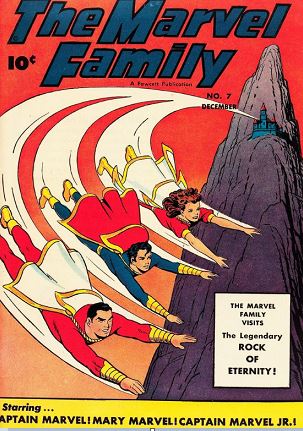
Freddy actually turned up before Mary did, making his debut in Whiz Comics #25 in 1941. Mary first appeared in Captain Marvel Adventures #18 in 1942.
Mary transforms by saying “Shazam”, while Freddy does by saying “Captain Marvel.”
That’s right, Captain Marvel, Jr. can’t say his own name.
Especially in his Fawcett days, many of Captain Marvel’s adventures had a whimsical element to them. Take one sequence in the “Monster Society of Evil” storyline that ran in Captain Marvel Adventures #s 22-46 from 1942-1944. The overall storyline pit Captain Marvel against a horde of villains led by the mysterious Mr. Mind.
Mr. Mind, we later learn, is a worm (literally). In the sequence in question, he attempts to prevent Captain Marvel from saving Russia (a wartime ally, don’t forget) by tickling him.
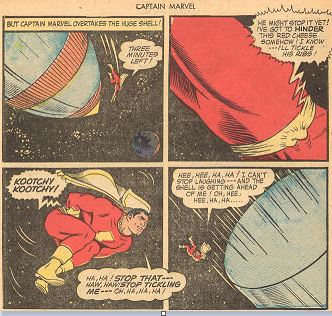
Mr. Mind tickles Captain Marvel.
Mr. Mind was one of many villains Captain Marvel faced. The first, and perhaps most persistent, was Dr. Thaddeus Bodog Sivana, a mad scientist who plotted to rule the universe and referred to Captain Marvel as “The Big Red Cheese.”
He also knew Billy Batson transformed into Captain Marvel.
Another was Black Adam, who had been the wizard’s chosen champion millennia ago in Egypt, before he turned evil. In more recent years, Black Adam has been depicted in various DC titles as a more complex anti-hero.
Among Captain Marvel’s allies was Mr. Tawny, a debonair, civilized tiger who wants to live in the city instead of the jungle.
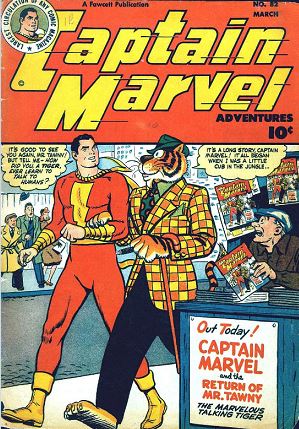
I mentioned that DC published a title called Shazam from 1973 to 1978. During that time, Captain Marvel would star in a Saturday morning TV series called Shazam, which would run from 1974-1977. That series was my introduction to the character.
In the comics, Captain Marvel would go on to make occasional subsequent appearances over the years, including as a member of the Justice League in the late 80s.
His longest post-Fawcett solo series, The Power of Shazam, ran for 47 issues starting in 1995. The series, which was set in Fawcett City and incorporated elements and characters from Fawcett Comics, as well as from the 1941 serial, followed on from the 1994 Power of Shazam graphic novel.
During the run of The Power of Shazam, the series with which I’m most familiar, Mary decided that she had just as much right to the name as her brother and also called herself Captain Marvel.
As for Freddy Freeman, he decided to go by “CM3.” At least he could now introduce himself.
Speaking of which, as of its “New 52” reboot, DC has taken to calling Billy Batson’s superhero persona “Shazam”, even though he’d been called “Captain Marvel” within the pages of the various comics in which he’d appeared. But doesn’t that mean he can’t introduce himself?
Apparently not. Seems Billy must say the word under the right conditions.
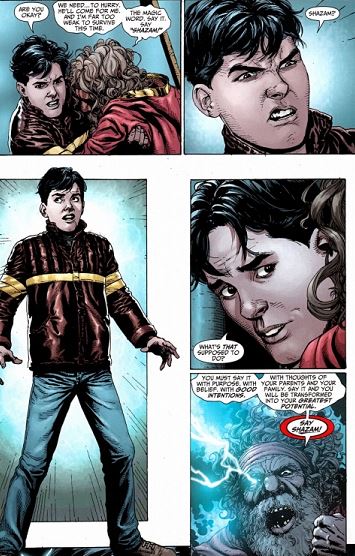
The New 52 Shazam.
So, I guess he can introduce himself as “Shazam” and not trigger the transformation, but what if he’s in a noisy, crowded room?
“I said ‘I’m Batman!’ What’s your name?”
“Shazam!”
BOOM!
“Hey, who let this kid in here?”
While The Power of Shazam is the longest-running series featuring Captain Marvel since his Fawcett days, he has appeared in several limited series. I especially enjoyed Shazam— The Monster Society of Evil, a four-issue 2007 series written and drawn by Jeff Smith, the creator of Bone. That miniseries, inspired by the original “Monster Society of Evil” storyline, has much of the whimsy of the Fawcett books.
In that miniseries, Captain Marvel is an adult, as per usual, but Mary Marvel remains a child.
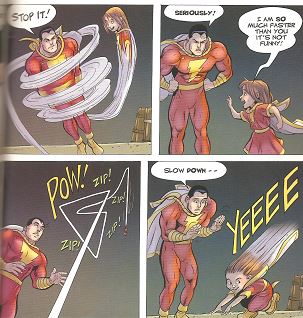
Mary Marvel flies circles around her brother.
It’ll be interesting to see how the upcoming movie Shazam portrays the character. From the trailers it seems clear that the filmmakers see Captain Mar- that is, Shazam as a kid in an adult’s body, but what sort of story will the film tell? Hopefully, a fun one.
As to the “Big Red Cheese” himself, his adventures have been assembled in various collections, including Shazam! From the Forties to the Seventies; The Shazam Archives; The Shazam Family Archives; Showcase Presents Shazam and Shazam! A celebration of 75 Years.
The storyline “Captain Marvel Battles the Plot Against the Universe”, which ran in Captain Marvel Adventures #100, was reprinted in A Smithsonian Book of Comic-Book Comics, while a story from Captain Marvel Adventures #1 was reprinted in Shazam!: The Golden Age of the World’s Mightiest Mortal.
Whether you call him Captain Marvel or Shazam, “The Big Red Cheese” is one of the best and most appealing superheroes of all time.
Copyright 2019 Patrick Keating.